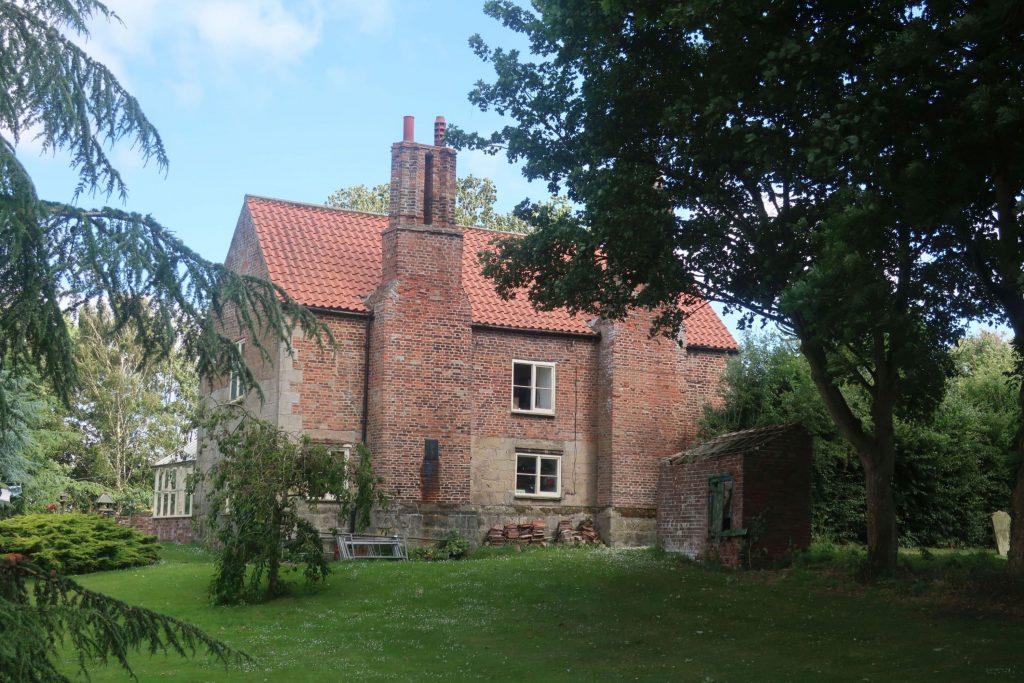
The parish of North Frodingham is situated in what was once the wapentake of Holderness, North division, part of the historical East Riding of Yorkshire (see maps in Introduction). Its boundaries remained unchanged after the 1832 parish boundary changes. The name of the parish is Anglian, meaning the settlement of the people of Froda. Froda also gave his name to the former hamlet of South Frodingham, which lay a good 40 kilometres to the south east in the parish of Owthorne, part of the South division of Holderness. (There is also a Frodingham in North Lincolnshire.) The village of North Frodingham lies in the northern part of the parish, where in the 16th century a manor house was recorded. It stood on the south side of Main Street and was rebuilt in c1810, but its place has now been taken by a modern housing estate which still retains a part of the surrounding walls. Unusually for the area, the village church stands a kilometre further west near Frodingham Beck. Further down the Beck, where it flows into the River Hull, are the handful of houses that make up Emmotland, meaning confluence, where there was a landing place. In 1767 Frodingham Beck was made a branch of the Driffield Navigation.

Ulf held the manor of North Frodingham in 1066, but by 1086 William the Conqueror had awarded it as part of the single holding of Holderness, along with estates in Lincolnshire, to Drogo de la Beuvrière, his companion in arms and relative by marriage. Soon afterwards Drogo fell out of favour and his confiscated lands were given to Odo, Count of Champagne. Odo married the king’s sister, Adelaide, Countess of Aumale, and the vast tracts of land in East Yorkshire and North Lincolnshire held by the couple were handed down to their descendants who took the title Aumale. It was their grandson William le Gros, Count of Aumale, who in the mid 12th century gave the manor and church of North Frodingham to the abbey he had founded at Thornton in Lincolnshire. In the mid 13th century the abbot was said to have prevented boats from passing up the Old Howe north of the North Frodingham and to have removed a bridge there, perhaps in order to discourage smuggling. At the Dissolution the manor was still part of Thornton Abbey’s possessions and as such reverted to the Crown. Initially let, in 1628 it was held by the trustees of the city of London as security for a loan, but was back in local hands from 1667 onwards, the principal owners being the Bethells of Rise.
A church and a priest were recorded at North Frodingham in 1086. In 1115 Stephen, Count of Aumale, the father of William le Gros, gave the church to Aumale priory in Normandy. Following Stephen’s death William revoked the gift, giving it instead to Thornton Abbey, probably at the same time as he gave the manor. The church remained in the possession of the abbey until the Dissolution. It was dedicated to St. Helen in 1519 and again in 1545, but the latter record was transcribed wrongly as St. Elgin and has been accepted ever since. The medieval church was made of boulders and rubble with stone dressings, comprising a chancel, nave and south doorway (later protected by a porch), all of 12th-century origin, with a 14th century north aisle, and a 15th century west tower. The nave was in disrepair in c1600, and in the early 18th century the chancel was repaired and its screen taken down. By the late 19th century the whole building had decayed to such an extent that in 1871 the school was being used for services. The chancel, nave and north aisle were restored from 1877 to 1878, and the tower repaired and heightened from 1891 to 1892 at the expense of Sir Tatton Sykes. The church contains part of a 10th century cross, the “most decorative and stylish in the East Riding”, a fragment of a 14th century cross depicting Atlas, and a 16th century parish chest. A vicarage was recorded in 1535, but had been demolished by 1685. The vicarage we see today was built in c1860.
 © John Knight, 2020 |  © Andy Beecroft, 2016 |  © Tom Middlemass |  next to graveyard, 2025 |
William Mercer Pickering of the 24th generation of the Pickerings of Wawne, an offshoot of the Pickerings of Holderness, was a blacksmith like his father and older brother. It seems safe to assume that he moved with his wife and his first three children to fill a vacancy at the smithy of North Frodingham. His other twelve children were born in the village. His first surviving son John and his grandson Thomas took over the position after him, another son Westoby remained in North Frodingham, but his other surviving sons moved away from the parish, James to London and George Mercer to the North Riding.
Sources:
https://www.genuki.org.uk/big/eng/YKS/ERY/NorthFrodingham
https://intel-hub.eastriding.gov.uk/parish-profile/#/view-report/bd6a0cb7f85a46998f874a42bfd0dc8e/PP107
https://en.wikipedia.org/wiki/North_Frodingham
https://opendomesday.org/place/TA0953/north-frodingham
Victoria History of the County of York, East Riding, vol. 7, pp. 261-269: https://www.british-history.ac.uk/vch/yorks/east/vol7/pp261-269
Bulmer’s History, Topography and Directory of East Yorkshire with Hull 1892, pp. 200-202: https://specialcollections.le.ac.uk/digital/collection/p16445coll4/id/324025
History and Topography of Yorkshire, vol. 2, York, Ainsty, East Riding, pp. 409-412: https://books.google.fr/books?redir_esc=y&id=unEKAQAAMAAJ
The Buildings of England, York and the East Riding, pp. 632-633: https://archive.org/details/yorkshireyorkeas0000pevs/page/632
Church of St. Elgin: https://historicengland.org.uk/listing/the-list/list-entry/1083362?section=official-list-entry
Tenth Century Cross: https://chacklepie.com/ascorpus/catvol3.php?pageNum_urls=97
